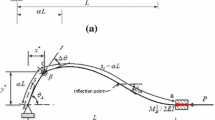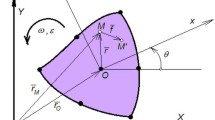Abstract
The deformation of circular-shaped elasticas, subjected to unilateral constraints due to ground contact, is studied under vertical loading. For C-shaped elasticas, we consider the cases where the elastica rolls without slipping due to the presence of friction and rolls while slipping due to lack of friction. The elastica behaves as a hardening spring in the absence of friction; in the presence of friction, it behaves as a softening or hardening spring depending on boundary conditions. For O-shaped elasticas, we consider symmetric and asymmetric loadings. Under symmetric loading, the stiffness of the elastica decreases with increase in the load while point contact is maintained; thereafter, the stiffness remains nearly constant while the elastica undergoes large deformation and makes line contact. Similar behavior is observed for a symmetric mass-elastica system. Asymmetric loading is studied by assuming that the initial point of contact of the elastica with the ground is fixed; vertical loading results in both vertical and horizontal motion of the point of loading. For the different statics and dynamics problems considered, the deformed shapes of the elasticas are obtained iteratively using an algorithm that solves a series of two-point boundary value problems.




















Similar content being viewed by others
Notes
The loading on the line segment may not be uniform; it is implicitly assumed that the line segment does not buckle.
It can be seen from Eq. (3a) that a constant value of \(\theta \) implies \(({\text {d}\theta }/{\text {d}s}) = 0\), which in turn implies that the curvature is constant and equal to zero. It will be seen later that the curvature is constant but not equal to zero for an initially curved elastica.
Note that the horizontal force p (see Fig. 2) is zero due to the absence of friction between the elastica and the ground.
It should be noted that the value of \(q_{\mathrm{cr}}\) is quite sensitive to the tolerance used to distinguish a line contact from a point contact.
Note that the value of \(\alpha \) is determined using the procedure discussed in Sect. 4.1.
Since the bending moments (horizontal forces) at the tip of the right and left VC-LES should be equal and opposite, the bending moments (horizontal forces) at the tip of the right and transformed left VC-LES are equal.
Note that the value of \(\alpha \) has to be determined at each time step using the procedure discussed in Sect. 4.3.
When the natural frequencies are not integer multiples of one another, the trajectory of the mass traces a path that does not repeat itself and is dense in a bounded region of the Cartesian space.
References
Wahl, A.M.: Mechanical Springs. Penton Publishing Company, New York (1944)
Frisch-Fay, R.: Flexible Bars. Butterworths, London (1962)
Shinohara, A., Hara, M.: Large deflection of a circular C-shaped spring. Int. J. Mech. Sci. 21(3), 179–186 (1979)
Wang, C., Watson, L.: On the large deformations of C-shaped springs. Int. J. Mech. Sci. 22(7), 395–400 (1980)
Srpčič, S., Saje, M.: Large deformations of thin curved plane beam of constant initial curvature. Int. J. Mech. Sci. 28(5), 275–287 (1986)
Wang, C.: Crushing an elastic-perfectly plastic ring between two point loads. Int. J. Non-Linear Mech. 23(3), 205–216 (1988)
Cannarozzi, M., Molari, L.: Stress-based formulation for non-linear analysis of planar elastic curved beams. Int. J. Non-Linear Mech. 55, 35–47 (2013)
Wu, C.H., Plunkett, R.: On the contact problem of thin circular rings. J. Appl. Mech. 32(1), 11–20 (1965)
Plaut, R., Klusman, C.: Two-dimensional analysis of stacked geosynthetic tubes on deformable foundations. Thin-Walled Struct. 34(3), 179–194 (1999)
Plaut, R.H., Suherman, S., Dillard, D.A., Williams, B.E., Watson, L.T.: Deflections and buckling of a bent elastica in contact with a flat surface. Int. J. Solids Struct. 36(8), 1209–1229 (1999)
Lu, Z.H., Chen, J.S.: Deformations of a clamped–clamped elastica inside a circular channel with clearance. Int. J. Solids Struct. 45(9), 2470–2492 (2008)
Chau, S., Mukherjee, R.: Kinetic to potential energy transformation using a spring as an intermediary: application to the pole vault problem. J. Appl. Mech. 86(5), 051001 (2019)
Chen, J.S., Ro, W.C.: Deformations and stability of an elastica subjected to an off-axis point constraint. J. Appl. Mech. 77(3), 031006 (2010)
Plaut, R.H., Virgin, L.N.: Deformation and vibration of upright loops on a foundation and of hanging loops. Int. J. Solids Struct. 51(18), 3067–3075 (2014)
Virgin, L.N., Giliberto, J.V., Plaut, R.H.: Deformation and vibration of compressed, nested, elastic rings on rigid base. Thin-Walled Struct. 132, 167–175 (2018)
Schmidt, W.F.: Nonlinear bending of beams using the finite element method. Comput. Struct. 8(1), 153–158 (1978)
Noor, A.K., Peters, J.M.: Penalty finite element formulation for curved elastica. J. Eng. Mech. 110(5), 694–712 (1984)
Golley, B.: The solution of open and closed elasticas using intrinsic coordinate finite elements. Comput. Methods Appl. Mech. Eng. 146(1–2), 127–134 (1997)
Santos, H.: A novel updated Lagrangian complementary energy-based formulation for the elastica problem: force-based finite element model. Acta Mech. 226(4), 1133–1151 (2015)
Saje, M.: Finite element formulation of finite planar deformation of curved elastic beams. Comput. Struct. 39(3–4), 327–337 (1991)
Fried, I.: Stability and equilibrium of the straight and curved elastica-finite element computation. Comput. Methods Appl. Mech. Eng. 28(1), 49–61 (1981)
Sitar, M., Kosel, F., Brojan, M.: A simple method for determining large deflection states of arbitrarily curved planar elastica. Arch. Appl. Mech. 84(2), 263–275 (2014)
Kierzenka, J., Shampine, L.F.: A BVP solver based on residual control and the Matlab PSE. ACM Trans. Math. Softw. 27(3), 299–316 (2001)
Press, W.H., Teukolsky, S.A., Vetterling, W.T., Flannery, B.P.: Numerical Recipes 3rd Edition: The Art of Scientific Computing. Cambridge University Press, Cambridge (2007)
Timoshenko, S.P., Gere, J.M.: Theory of Elastic Stability, 2nd edn. McGraw-Hill, New York (1961)
Acknowledgements
The first author gratefully acknowledges the support provided by the National Science Foundation graduate research fellowship program, Grant No. DGE-1424871.
Author information
Authors and Affiliations
Corresponding author
Additional information
Publisher's Note
Springer Nature remains neutral with regard to jurisdictional claims in published maps and institutional affiliations.
Rights and permissions
About this article
Cite this article
Chau, S., Mukherjee, R. Force–displacement characteristics of circular-shaped massless elastica. Acta Mech 231, 4585–4602 (2020). https://doi.org/10.1007/s00707-020-02766-9
Received:
Revised:
Published:
Issue Date:
DOI: https://doi.org/10.1007/s00707-020-02766-9




